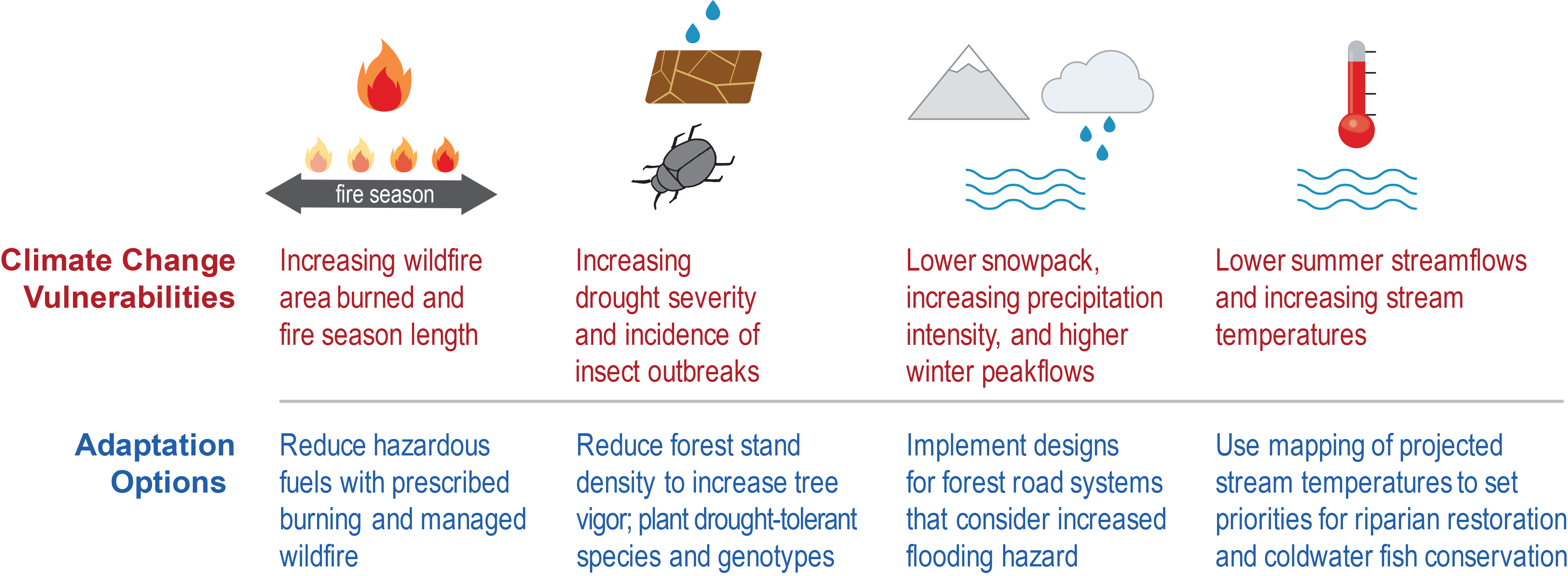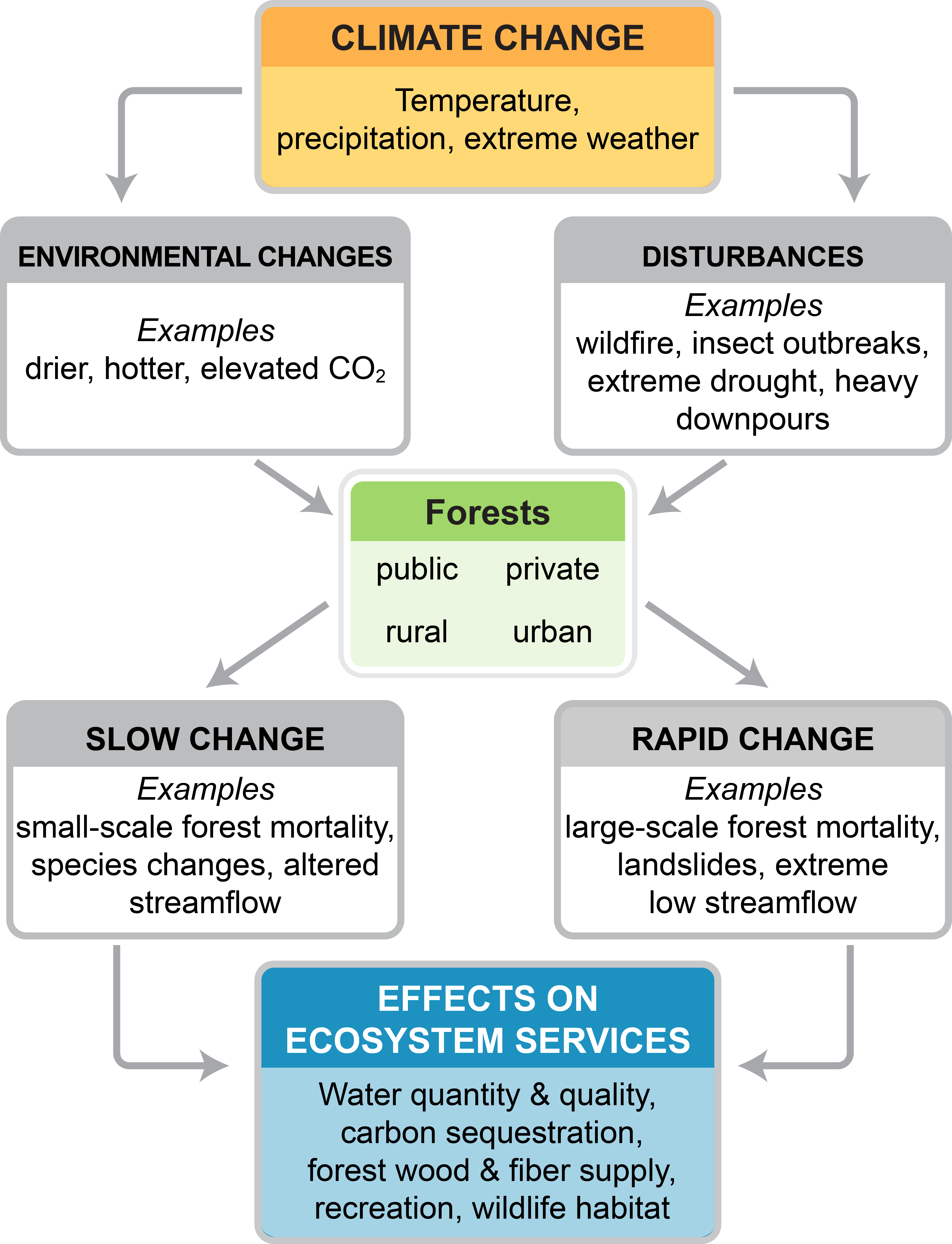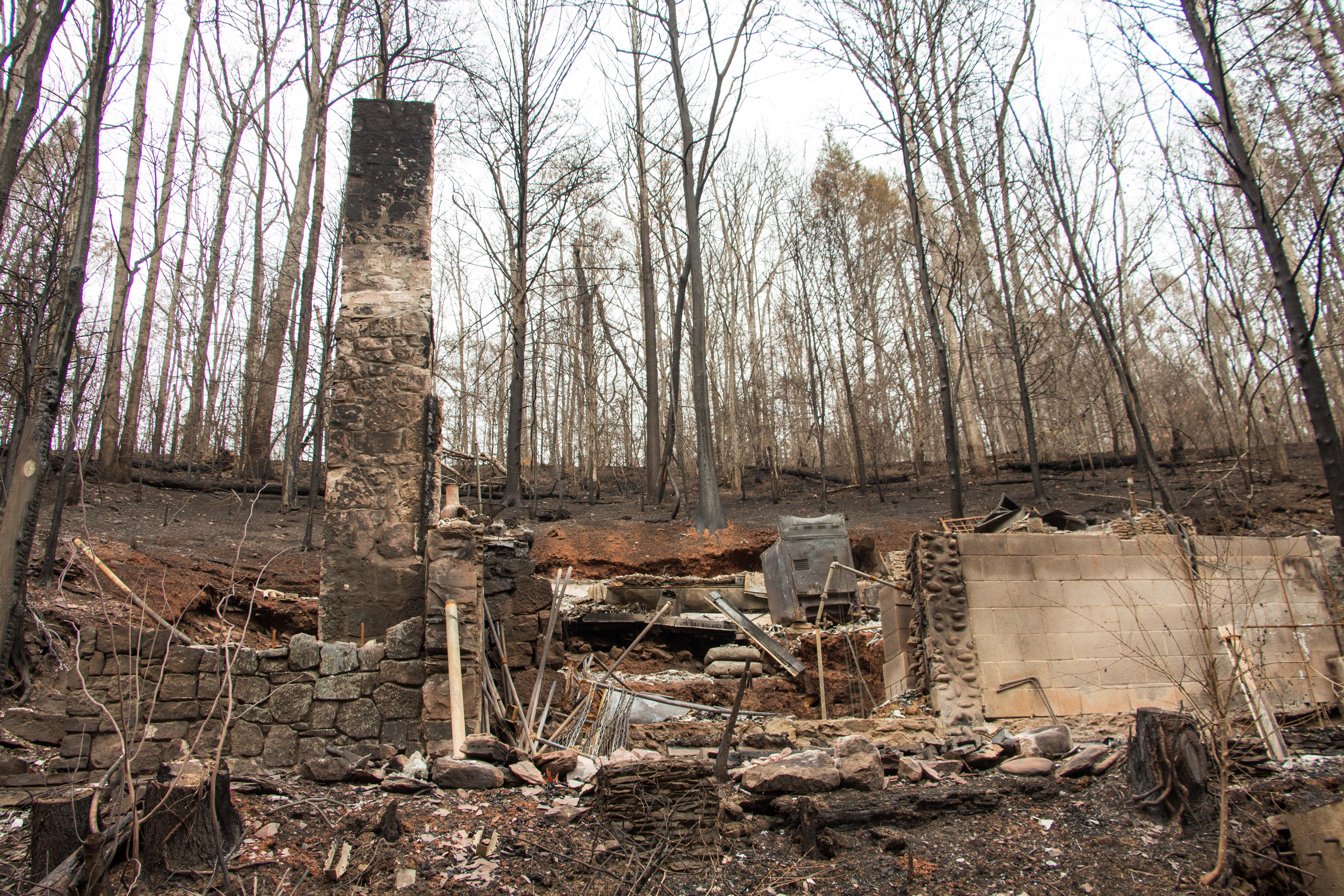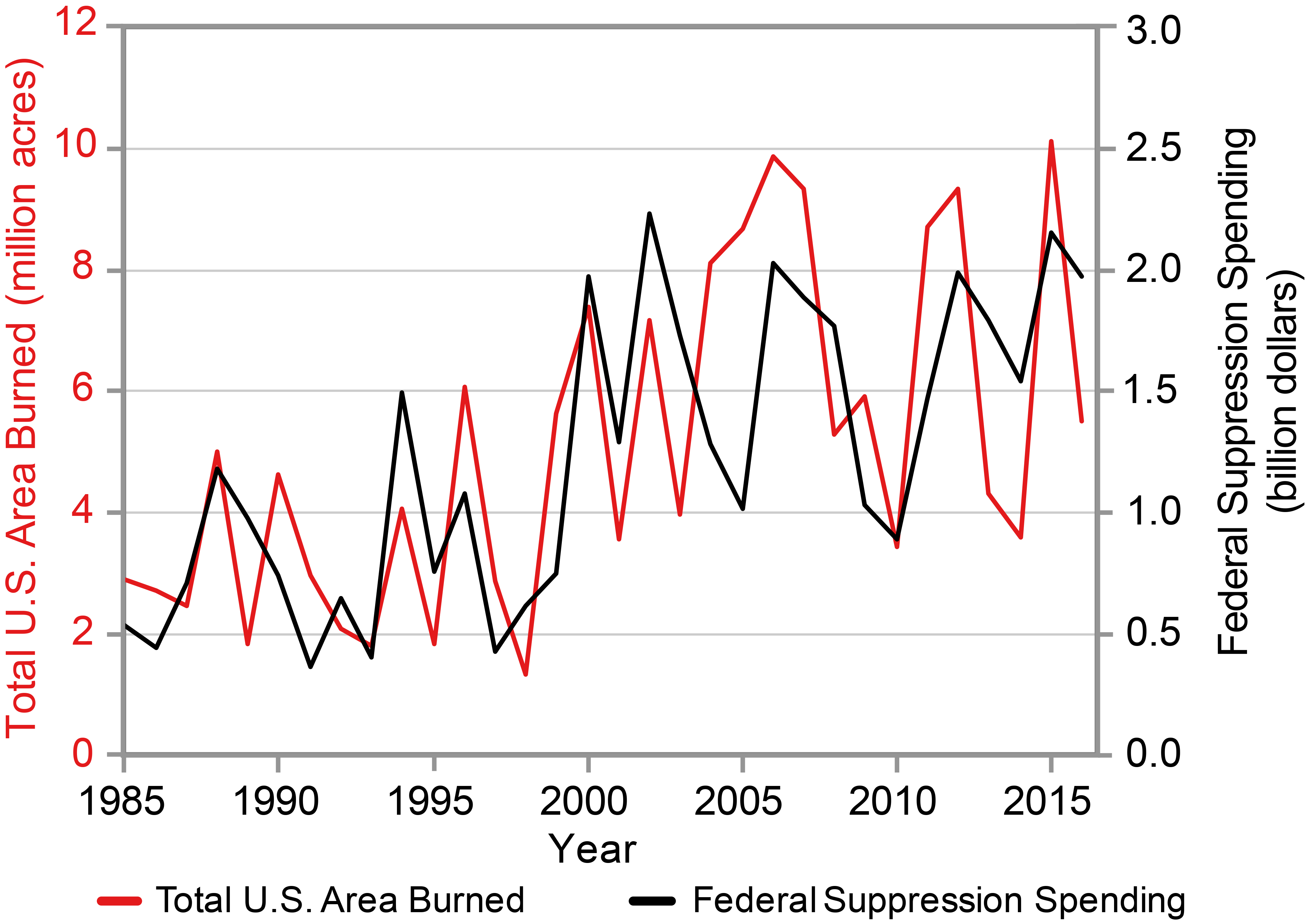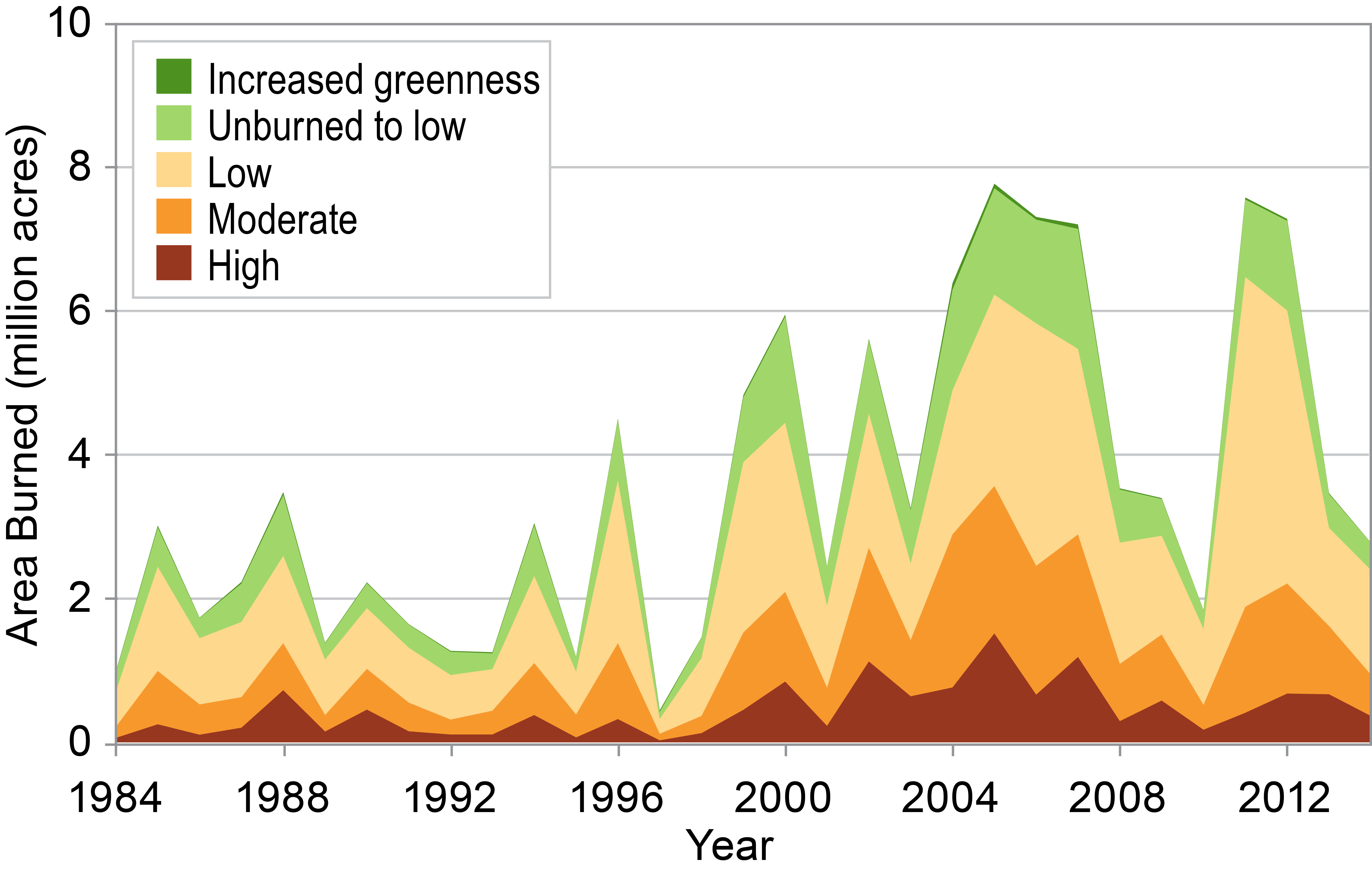Lead authors, chapter authors, and technical contributors engaged in multiple technical discussions via teleconference between September 2016 and March 2018, which included a review of technical inputs provided by the public and a broad range of published literature as well as professional judgment. Discussions were followed by expert deliberation on draft Key Messages by the authors and targeted consultation with additional experts by the authors and technical contributors. A public engagement webinar on May 11, 2017, solicited additional feedback on the report outline. Webinar attendees provided comments and suggestions online and through follow-up emails. Strong emphasis was placed on recent findings reported in the scientific literature and relevance to specific applications in the management of forest resources.
Key Message 1: Ecological Disturbances and Forest Health
It is very likely that more frequent extreme weather events will increase the frequency and magnitude of severe ecological disturbances, driving rapid (months to years) and often persistent changes in forest structure and function across large landscapes (high confidence). It is also likely that other changes, resulting from gradual climate change and less severe disturbances, will alter forest productivity and health and the distribution and abundance of species at longer timescales (decades to centuries; medium confidence).
Description of evidence base
Many ecological responses to climate change in U.S. forests are mediated though disturbance, because the occurrence and magnitude of most major forest disturbances are sensitive to subtle changes in climate.1 Published literature since the Third National Climate Assessment (NCA3) continues to show an increase in the frequency of large (thousands to hundreds of thousands of acres) ecological disturbances in forests across the United States. There is strong evidence that these changes, in combination with accumulated fuels, have resulted in larger wildfires in recent years (the past 10 to 20 years),2,38,39 making them harder to suppress and increasing human health and safety concerns for nearby communities40 and wildland firefighters.157 Fire suppression costs continue to increase in response to larger fires and an expanding wildland–urban interface.
Although the increasing size and costs of fighting wildfires are known with high certainty,158 short- and long-term effects on forests vary according to the ability of tree species to survive or regenerate after wildfire.159 Future fire regimes and their impacts on U.S. forests will be governed by climate as well as topography, ecosystem productivity, and vegetation adaptations to fire. For example, altered distribution and abundance of dominant plant species may affect the frequency and extent of future wildfires (Ch. 29: Mitigation). The potential of an area to reburn (that is, burn again after experiencing a previous fire) will depend on how the previous fire was suppressed, the severity of that fire, how rapidly fuel accumulated after the fire, and postfire management activities.53 These variables create uncertainty in predicting the spatial distribution, number, and sizes of wildfires in future decades.
The published literature contains strong evidence that insects are causing rapid changes in forest structure and function across large landscapes. Causal factors are primarily elevated temperatures, droughts, and water stress, which exert indirect effects mediated through host tree species and direct effects on insects. For example, in western North America, several species of bark beetles have had notable outbreaks over the past 30 years, and some have exceeded the spatial extent of what has been previously documented, affecting ecosystem services at broad spatial scales.3 The spatial extent of recent outbreaks of mountain pine beetles represents an area larger than the 11 smallest U.S. states combined, and insect outbreak models project increased probabilities of mountain pine beetle population success in the future.23 In addition, evidence suggests that climate change is expanding the range of bark beetles in both the western and eastern United States,66,70,71 caused by higher minimum temperatures associated with climate change. For example, whitebark pine is expected to suffer significant mortality in future decades due to the combined effects of white pine blister rust, mountain pine beetles, and climate change.74
The magnitude and direction of defoliator responses to climate change vary, limiting our ability to project the effects of climate change69 and preventing generalizations about climate-related effects on defoliators, despite their importance throughout the United States. Fungal pathogens that depend on stressed plant hosts for colonization are expected to perform better and have greater impacts on forests.63,75,76 In contrast, some pathogens directly affected by moisture availability (for example, needle blights) are expected to have reduced impact.75
Mounting evidence suggests that some bird and insect populations show changes in distribution that align with temperature increases in recent decades (Ch. 7: Ecosystems).160,161,162,163 These species groups are characterized by short generation times, high mobility, or both. Some evidence suggests that the rate of climate change is outpacing the capacity of trees and forests to adjust, placing long-lived tree populations at risk. Species distribution models concur that climate change can affect suitable habitat,11 although it is unclear if these effects are translating into species range shifts. Some studies report shifts in elevation ranges,97,98 whereas others do not.100,101,103 In summary, evidence indicates substantial effects of climate change on forest health but varied capacity for tree species to relocate as conditions change.
Understanding and predicting the effects of climate change on forests are obscured by the slow response times of long-lived trees.87 Increasing evidence suggests that climate-related stresses weaken trees, predisposing them to additional stresses that take many years to be observed,88 and that growth reductions following drought can persist for years.7,90,91 For species in which seed crops depend on resources stored over several growing seasons, it is likely that reproductive responses will lag behind climate variation.92 Recent studies in the eastern United States suggest that changes in tree species composition (such as an increased proportion of mesophytes) over the past few decades in some forests are contributing to lower streamflow136 and increased vulnerability of forests to drought.164 Warming temperatures and changing precipitation are altering leaf phenology (for example, earlier spring leaf-out and later leaf fall) in some areas, which is likely to affect forest carbon and water cycling.95,165
Major uncertainties
Although wildfire frequency and extent are very likely to increase in a warmer climate, spatial and temporal patterns of fire are difficult to project, especially at smaller than regional scales. The effects of a warmer climate are well known for some insect species (such as bark beetles), but the effects of long-term thermal changes on most insect species and their community associates are uncertain. Scientific information on the effects of climate change on fungal pathogens is sparse, making projections of forest diseases uncertain. It is possible to project that some tree species will have decreased growth and others increased growth, but the magnitude of growth changes is uncertain. Finally, species distribution and abundance are likely to change in a warmer climate, but the magnitude, geographic specificity, and rate of future changes are uncertain.
Description of confidence and likelihood
Published literature and model projections imply high confidence that more frequent extreme weather events will increase the frequency and extent of large ecological disturbances, driving rapid (months to years) and often persistent changes in forest structure and function across large landscapes. Forests are long-lived and inherently resilient to climatic variability, so long-term monitoring (of, for example, growth and productivity, structure, regeneration, and species distribution and abundance) will be needed to confirm the direct effects of incremental changes in temperature. As a result, there is medium confidence that changes resulting from direct (but gradual) climate change and less severe disturbances will occur in the context of altered forest productivity, health, and species distribution and abundance that occur at longer timescales (decades to centuries).
Key Message 2: Ecosystem Services
It is very likely that climate change will decrease the ability of many forest ecosystems to provide important ecosystem services to society. Tree growth and carbon storage are expected to decrease in most locations as a result of higher temperatures, more frequent drought, and increased disturbances (medium confidence). The onset and magnitude of climate change effects on water resources in forest ecosystems will vary but are already occurring in some regions (high confidence).
Description of evidence base
Altered forest conditions caused by a changing climate are likely to influence the quantity and quality of many of the ecosystem services that humans derive from forests, and climate change is expected to increase the frequency and severity of natural disturbances in the coming decades and to reduce forest growth in most places.18 Extreme high temperatures can also cause heat-related stress in vegetation and exacerbate drought conditions, potentially increasing tree mortality and reducing forest productivity.7,166 Positive effects of carbon dioxide (CO2) on growth will be negated in some species and locations by low soil fertility167 and by air pollutants such as ground-level ozone, where concentrations of those pollutants are high enough to cause toxic effects in plants.84
Most evidence suggests that increased carbon sinks (caused by higher growth rates and more forest area in some regions) will not be sufficient to offset higher emissions from increased disturbances and enhanced release of carbon from decomposition in the future.114,168,169,170 U.S. forests are projected to continue to sequester carbon but at declining rates caused by land-use change and aging forests.18 In the western United States, the aging of forests, coupled with disturbance dynamics, is projected to diminish carbon sequestration to negligible levels by around 2050, and some forests (for example, dry western forests with frequent fire and some eastern hardwood forests) will likely become a carbon source.18 Younger productive forests in the eastern United States portend high carbon uptake rates, although harvest-related emissions substantially reduce the net effect on atmospheric carbon.
Land-use change that increases forest cover (such as cropland converted to forestland) is a major contributor to reductions in atmospheric CO2,116 but this conversion is expected to slow in the near future.118 The estimated net carbon flux in the United States associated with forestland conversion is approximately zero, with gains in forestland constituting +23 teragrams (Tg) of carbon per year and losses resulting in emissions of −23 Tg carbon per year over the last decade. The estimated emissions constitute decades, and in some cases centuries, of accumulated carbon within forest ecosystems, which is abruptly or gradually released to the atmosphere during conversion from forest to nonforest land. In contrast, gains in forestland represent carbon sequestration only from new growth of live biomass and the accumulation of newly dead organic matter over the 20 or so years since the renewal of forest cover.
Economic conditions and population growth will affect national and global production and consumption of wood products, which can temporarily sequester carbon (currently 189 Tg carbon per year, or 8% of the global forest sink).120 Increases in wood products carbon are contingent on a sustained or increasing rate of harvest removals of forest carbon or on a shift toward forest products that exist for long periods of time before they are no longer suitable for reuse or recycling. In the United States, 76% of the annual domestic harvest input to the wood products pool in 2015 (110 Tg carbon) was offset by release processes (84 Tg carbon), yielding a corresponding net increase in wood products of 26 Tg carbon.14 However, if harvest rates decline (as they did in 2007–2009, during the last economic recession), net additions to wood products will likely be lower than emissions from wood harvested in prior years.14 Looking ahead, carbon storage in wood products is expected to increase by 7–8 Tg carbon per year over the next 25 years.171
Snowfall amount, timing, and melt dynamics are affecting water availability and stream water quality in the western United States, where less precipitation is falling as snow and more as rain in winter months, leading to longer and drier summer seasons.121 Furthermore, rapid opening of forests in the western United States by wildfire has caused faster spring snowmelt through increased solar radiation and decreased reflectivity of radiation from charcoal,128 leading to drier summer conditions that offset increased water yield following a disturbance.127 The persistence of winter snowpack in the northeastern United States has declined over the last few decades; mid-winter thaws have become more common, and snowmelt flushing of mobilized soil nutrients into streams has become less common, although increased variability in climate–hydrology interactions can alter flushing.172
Major uncertainties
It is difficult to identify geographically specific changes in forest conditions at fine scales because of high spatial variability in forest structure and function and variability in projections of climate change and how it will affect large disturbances (drought, wildfire, insect outbreaks). Uncertainties about the rate and magnitude of climate change effects on carbon sequestration are moderately high, because it is difficult to project future trends in forest cover and socioeconomic influences on forest management (for example, demand for wood products, bioenergy). Although empirical evidence for young trees indicates that atmospheric enrichment of CO2 can enhance tree growth, few long-term data on mature trees are available on which to base inferences about long-term forest productivity.173 Temporal patterns and magnitude of carbon sequestration, especially after 2050, will be affected by uncertainties related to future land-use conversions (from forests to other uses and vice versa) and the production of wood products.
Description of confidence and likelihood
Because of variability in forest structure and function and species-level variation in adaptive capacity to climate change, it is difficult to project future changes in forest conditions at smaller than regional scales. Hence, there is medium confidence about how ecosystem services will be affected in different forest ecosystems, including effects on tree growth and carbon storage, as a function of higher temperature, more frequent drought, and increased disturbance. Observations from recent droughts and changing snowfall/snowmelt dynamics provide high confidence that climate change effects on water are already occurring in some regions, although the onset and magnitude of future effects will vary regionally.
Key Message 3: Adaptation
Forest management activities that increase the resilience of U.S. forests to climate change are being implemented (high confidence), with a broad range of adaptation options for different resources, including applications in planning (medium confidence). The future pace of adaptation will depend on how effectively social, organizational, and economic conditions support implementation (high confidence).
Description of evidence base
Climate change vulnerability assessments and adaptation planning efforts for forest ecosystems have been conducted at many locations (for example, forests in the western United States and upper Midwest) over the last decade.19,140,141,144,174 These efforts have produced a broad range of adaptation options, including climate-informed practices for forest density management, water management, road management, and restoration.19,144,175
In general, practices that mitigate stressors in forest and aquatic systems increase resistance (the ability of a system to withstand a perturbation) and resilience (the ability of a system to return to a previous state after a perturbation) to climate change.127,144 For example, restoring riparian vegetation helps to stabilize stream banks and provides shade to streams, thus helping to moderate stream temperatures.127 Similarly, culvert replacement under forest roads can improve fish passage and reduce damage from flooding events.127 Tools are now available to help in the prioritization of aquatic and riparian habitat restoration.150
There is strong evidence that stand density management can increase forest resistance and resilience to disturbances, including wildfire and bark beetle infestations in dry forest types. A growing body of evidence suggests that reducing stand density in most forest types can increase forest resilience to drought by increasing soil water availability and decreasing competition.146,148,176 Reductions in stand density, combined with hazardous fuel treatments, can increase resilience to wildfire by reducing wildfire intensity and crown fires in western dry conifer forests and southern conifer forests.141,145,174 Evidence also suggests that stand density management can reduce the incidence of bark beetles and subsequent mortality in some coniferous forests (for example, lodgepole pine forests).177 All of these practices—in addition to “firewise” practices near buildings and infrastructure on public and private lands 178 and the use of prescribed fire where possible—improve the resilience of organizations and communities to increased frequency of wildfire.179
Wildfire has been an important disturbance in aquatic ecosystems for millennia,180 and its frequency will increase in the future. Management responses to changing climate and fire regimes will need to be developed in the context of how past land use impaired aquatic function. Coordinating restoration in adjacent riparian and forest habitats can help ensure that beneficial effects of fire are retained across the aquatic–terrestrial interface.181
Examples of on-the-ground implementation of adaptation options to increase ecosystem resistance and resilience to climate change are emerging in the scientific literature.138,139,141 However, exploration of potential management actions is more common than on-the-ground action,18,19,127,140,145,175 suggesting that implementation is still in the early stages.
Major uncertainties
Evidence for the long-term effectiveness of climate change adaptation is derived primarily from our current understanding of how specific actions (for example, forest thinning, restoration of riparian systems, conservation of biodiversity) sustain the functionality of terrestrial and aquatic systems.127 Physical and biological conditions of ecosystems are constantly changing, and interactions among multiple ecosystem stressors could have unforeseen outcomes on ecosystem composition, structure, and function. Thus, the long-term effectiveness of adaptation actions for increasing forest resistance and resilience to climate change is uncertain until a sufficient time series of monitoring data is available, requiring decades of observations.
The future pace of adaptation and barriers to its implementation are also uncertain, and it is expected that many forest management challenges will persist in the future. However, new challenges and barriers may emerge,182 and it is difficult to predict how society and organizations will respond.
Description of confidence and likelihood
There is high confidence that climate change adaptation planning in forest management is occurring, particularly in U.S. federal agencies (especially national forests in the western and northeastern United States) (Ch. 28: Adaptation)19,140,175 and Native American tribes.142 Because of the limited number of examples in the scientific literature, there is medium confidence that adaptation planning is progressing to the application stage, where forest management plans are altered and on-the-ground management activities are implemented to mitigate the effects of climate change. However, there is high confidence that future progress in climate change adaptation planning and implementation will depend on social, organizational, and economic conditions.
